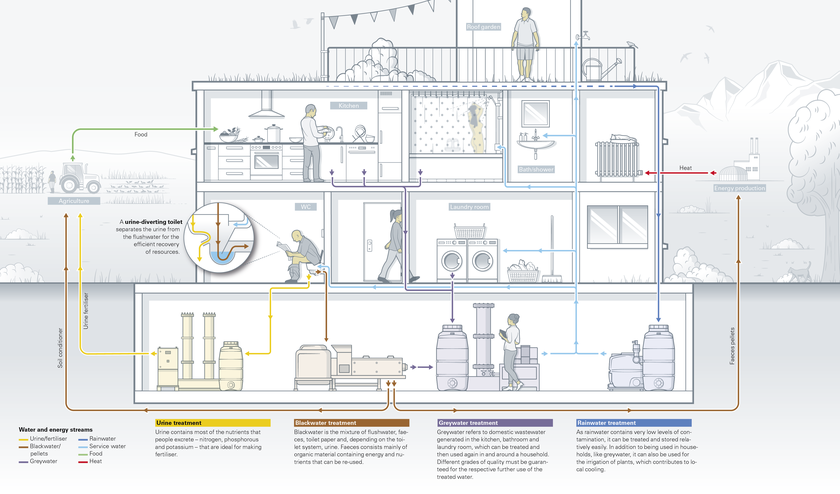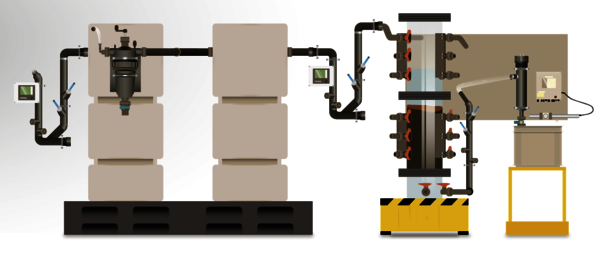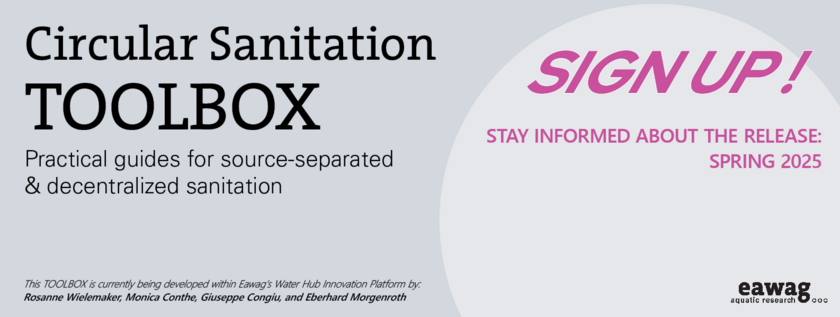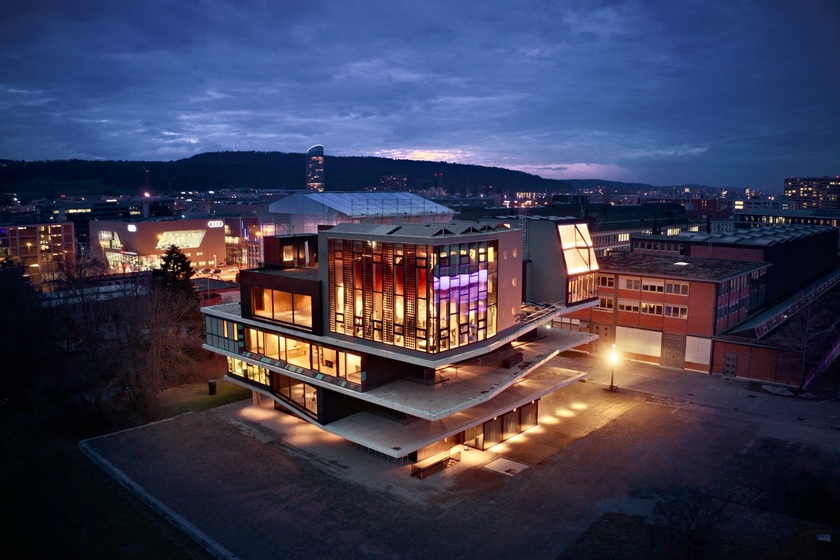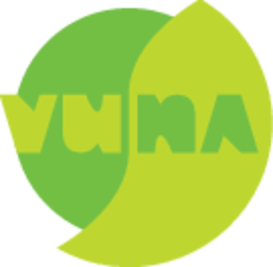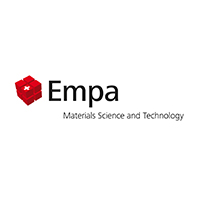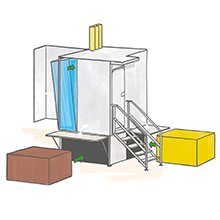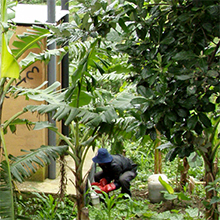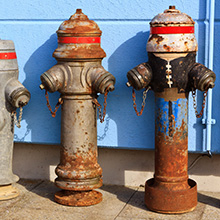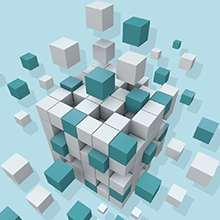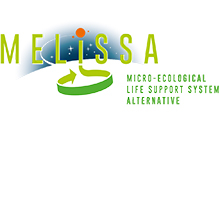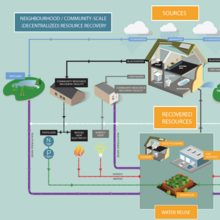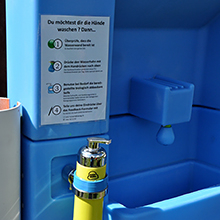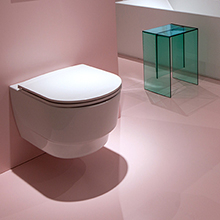Department Process Engineering
Water Hub at NEST
Water Hub at NEST – decentralised resource-oriented sanitation
The Water Hub is part of the NEST building, a living laboratory by Empa and Eawag. This modular building consists of replaceable units, which provide functioning and used apartments, offices, meeting rooms and a fitness and wellness unit. NEST is in constant evolution. Innovative and sustainable building solutions are developed, built, tested and displayed under real conditions. This Living Lab approach helps to bridge the gap between research and industry and thereby accelerates the market entry of innovative technologies.
In the basement of NEST, Eawag researchers run the Water Hub. Wastewater from NEST is collected here to be handled as a resource rather than a waste: we treat wastewater to recover nutrients, clean water, and energy. This allows to reduce pressure on the environment and its resources.
Our approach is decentralised: we separate wastewater streams at the source and treat them within the building, which increases efficiency of treatment and recovery. Decentralised treatment can be especially useful where sewer networks and treatment plants cannot be built or to reduce pressure on these infrastructures, particularly in areas with rapid urban growth. Decentralisation also allows for a systemic approach when designing sanitation solutions for different contexts, making the most of the resources made locally available by treating wastewater.
In NEST special toilets separate undiluted urine from flushwater, faeces and toilet paper; which together constitute blackwater. Other wastewater streams are kept apart using separate piping networks. These networks transport to the water hub the so called light greywater, coming from washing machines and bathroom drains; and heavy greywater, coming from the kitchens. Rainwater is also collected, stored and reused to flush the toilets in NEST.
The Water Hub is also a platform for researchers and partners from industry and practice to collaborate. Technologies enabling decentralised resource-oriented sanitation can be installed in units within NEST or tested in the Water Hub. The Water Hub is open for collaboration with industry and makes seed funding available to initiate small projects to assess the potential of novel concepts and technologies.
Furthermore, the Water Hub is interested in exchange with actors of the sanitation, construction, energy and agriculture sectors, to discuss the influence of decentralised resource-oriented sanitation on their domains and the integration in their projects.
You can visit the Water Hub and NEST in public guided tours!
The Water Hub’s focus comprises the following ongoing and concluded projects:
NoMix Toilets
Thanks to NoMix toilets it is possible to separate urine and faeces to treat them separately. Urine is produced in small volumes and relatively free of pathogens. Humans excrete most of the nutrients, antibiotics and micropollutants through urine. Faeces, discharged with flush water, consist mostly of organics and have a much higher pathogen content. It is advantageous to treat the two streams separately.
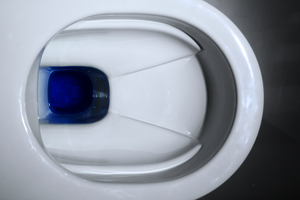
For 20 years, Eawag has tested under real-life conditions different prototypes of NoMix toilets, with separation mechanisms ranging from mechanical to sensor-based. These tests highlighted the need for a more robust separation mechanism and a user-friendlier toilet.
The Austrian designer Harald Gründl from EOOS next has developed a novel NoMix toilet with an innovative separation mechanism, invisible to the user and functioning without any mechanical part or sensor.
The toilet uses surface tension and the different speed at which urine and flush water flow down the toilet bowl to separate the two streams. The geometry was optimized in collaboration with Laufen and ETH Zurich. These novel toilets are now installed and tested in NEST.
This system is more robust and efficient than previous solutions and promises to revolutionise urine-diversion
Nutrient Recovery from Urine
Humans excrete the largest proportion of nutrients with urine. In the Water Hub, the nutrients from urine are recovered in the fertilizer "Aurin" using the VUNA process : after storage, volatilization of ammonia from urine is prevented with the help of nitrifying bacteria. Next, pharmaceuticals are removed in an activated carbon filter. Finally, the treated urine is concentrated and pathogens are killed during distillation.
Researchers are currently:
- developing variations of the VUNA-process, e.g., by supporting bacteria with electrochemistry;
- optimizing pharmaceutical removal with activated carbon;
- using data from the plant to optimise energy consumption, costs, maintenance and to increase process reliability.
On urine treatment, the researchers of the Water Hub closely collaborate with the Eawag Spin-off Vuna.
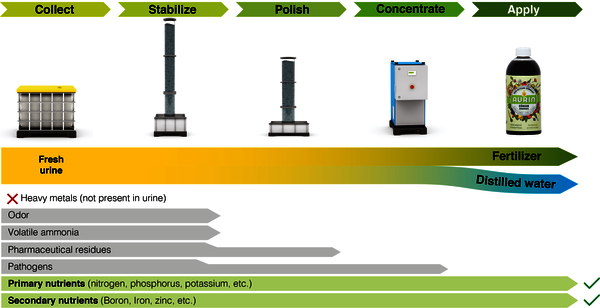
Treatment and Reuse of Greywater
Treatment Process
Domestic wastewater consists of greywater and waste streams from the toilet. Instead of mixing these streams and discharging them to the sewer, there are opportunities to treat and reuse greywater within the building for applications such as toilet flushing and irrigation, to showering and handwashing. The intended reuse dictates the required quality of the treated greywater . It also dictates how robust, reliable and closely monitored the treatment will have to be.
Treatment Process
In the Water Hub, Eawag researchers compare the performance of distinct greywater treatment systems. This allows to design flexible treatment systems which produce different water qualities depending on the intended end use. It also allows our researchers to adapt the system to the research question they want to answer. Current foci are on:
- Advanced treatment using a sequence of membrane bioreactor and biologically activated carbon followed by disinfection (UV or chlorine) and potentially nanofiltration (for advanced reuse)
- Predicting microbial safety using simple sensors
During the testing of new treatment processes the treated water is discharged into the sewer. But the ultimate goal is to reuse the treated water within the building.
Microbial Greywater Quality
Enteric pathogens
Greywater too can contain significant concentrations of enteric pathogens. It must therefore be treated to reduce human health risks to an acceptable level. Eawag researchers are currently validating the capability of individual and combined treatment processes to reduce pathogens under a range of operating conditions. This treatment validation procedure will guide the design of whole treatment process trains to ensure that greywater can be safely reused for different applications.
Enteric pathogens
Opportunistic pathogens (growth during storage)
Building-scale reuse of greywater will require treatment, storage, and re-distribution. During these steps, water must remain safe for re-use from the perspectives of both human health and system performance. Within the Water Hub, Eawag researchers are monitoring and evaluating the impact of greywater treatment on microbial and chemical quality during subsequent storage and distribution. In particular, we want to:
- monitor physicochemical characteristics of treated water during storage and treatment,
- monitor microbiological growth and/or stability,
- identify methods for monitoring, predicting, and preventing microbial water degradation,
- investigate factors influencing growth and community-shift potential
Opportunistic pathogens (growth during storage)
Resource Recovery from Blackwater
Blackwater consists of faeces, urine, toilet paper and flushwater. The high nutrient and energy content of faeces offers a great potential for resource recovery. Additionally, flush water could be treated and reused. In order to safely recover nutrients, energy and water from blackwater, solid-liquid separation (dewatering) is required.
Extensive research exists on dewatering of sludge from municipal wastewater treatment. However, scaling existing technologies to non-sewered systems has proven difficult, due to the high variability in blackwater characteristics.
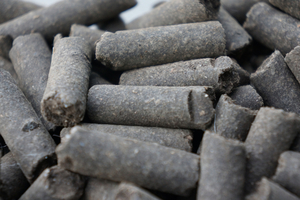
In the Water Hub, blackwater is used for both fundamental research and for practical technology development:
- Current research focuses on gaining understanding of dewatering behaviour to develop better monitoring and control during treatment.
- Blackwater collected in the Water Hub is used to test and develop various dewatering technologies, which are suitable for treatment and resource recovery in NEST and at a global scale.
Possible resource recovery from the dewatered solid fraction of blackwater includes energy, nutrients and organic matter, biomass, and water.
Linking Energy and Water – Project Concluded
Systems providing hot water for domestic use consume large amounts of energy. Upcoming technologies show significant potential to optimize energy consumption. Several of these technologies are being tested in NEST: the DFAB House unit displays showers, which recycle heat contained in greywater. Additionally, an innovative water distribution system reduces energy and water losses by emptying the drinking water pipes when no water is needed.
While these technologies are promising, their integration into complex domestic hot water systems must be investigated carefully, as interactions with other parts of the system may limit their energetic and economic potential due to intricate relationships between energy and water consumption called the water-energy nexus.
Eawag researchers have developed a model to better integrate combinations of technologies in a domestic hot water system. They have applied the model at multiple scales to investigate the influence of these technologies on the entire urban water cycle: from the households, through the sewer network, down to the wastewater treatment plant. As part of this project, a study showed for instance that recovering – and reusing – heat within a building is often a better option rather than recovering it in the sewer network. This is due to lower impacts on biological processes in the wastewater treatment plant.
Documentation
Further information on the Water Hub can be found in the following articles and publications.
Media & Articles
Reusing shower water, Eawag News (09.09.2021)
Ressourcen aus Abwasser direkt im Gebäude zurückgewinnen, Wohnen (September 2021)
Visit the Water Hub virtually, Eawag News (11.06.2021)
Mise au point - Toilettes: Merci de ne pas tirer la chasse, RTS (06.06.2021)
Projekt Sanitärwende - Wenn Kot zu Kompost auf dem Acker wird, Zeitfragen Deutschlandfunk Kultur (01.06.2021)
NEST Podcast with Tove Larsen, Eawag News (25.03.2021)
Water Hub Phase II, WINGS-Newsletter (17.03.2021)
Reuse of Greywater - yes, but how?, Eawag News (23.02.2021
Toilettes et durabilité (2/5) – Des ressources dans les eaux usées ?, RTS on va vers le beau (12.01.2021)
Wastewater is a source of nutrients, energy and water, Eawag News (29.09.2020)
Abwasser - von der Giftbrühe zur Goldgrube, NZZ Format (03.09.2020)
Water Hub im NEST-Gebäude. Eine Plattform zum Testen von innovativen ressourcenorientierten Sanitärsystemen, Aqua & Gas, 100(2), 52-57 (February 2020)
"A toilet that separates", SRF News (19.11.2019)
Water reuse, Haustech (October 2019)
Tove Larsen explains the toilet revolution, Eawag News (03/11/2019)
Report on the Water Hub in "Il giardino di Albert", RSI (01/08/2017)
"The toilet of the future", Empa Quarterly (May 2016)
Report on the NEST inauguration, SRF Tagesschau (05/23/2016)
Article on the NEST inauguration, NZZ (05/23/2016)
Conference papers
Publications
Flyer
Resource-Oriented Sanitation :: Circular Economy with Wastewater
Resource-Oriented Sanitation :: Circular Economy with Wastewater
Team
Project team
The Water Hub @ NEST team in fall 2023.
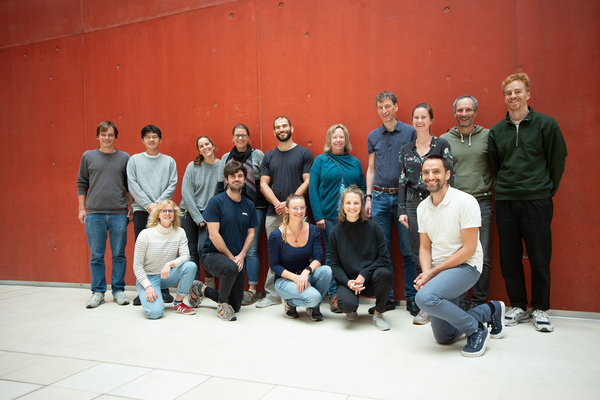
Verhebts? Ein ressourcenorientierter Apéro
Film
News
Old and New – Part 2, Wastewater. «Schweiz aktuell» SRF Live (18.07.2023)
Siamo a secco! SRI Falò (04.05.2023)
Documentary: The great toilet battle (04.10.2022)
Verhebts? Ein ressourcenorientierter Apéro, VSA News (29.09.2022)
Schöne Scheisse: Fäkalien sind nicht «wäh», sondern «wow», SRF Input (01.06.2022)
Interview: Abwasseraufbereitung direkt im Haus, Planet Wissen (30.05.2022)
Das nachhaltige Quartier von Morgen, Podiumsdiskussion Swissbau Focus 2022 (06.05.2022)
Spezial Newsletter Fokus: Dezentral Ressourcen aus Abwasser gewinnen, Eawag (Mai 2022)
In order to close nutrient cycles, many stakeholders must work together, Eawag News (05.05.2022)
Recovering energy from faeces, Eawag News (12.04.2022)
Wasser - Die wertvolle Ressource, SWR Odysso (17.03.2022)
Let's collaborate on developing technologies for resource-oriented sanitation, Wings Newsletter (16.03.2022)
The Secrets of Sewer Water, Arte (14.03.2022)

